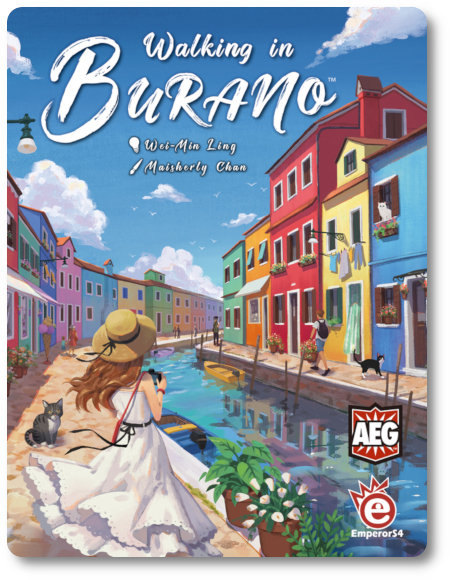
The Basics:
- For ages 10 and up (publisher suggests 14+)
- For 1 to 4 players
- Approximately 30 minutes to complete
Geek Skills:
- Counting & Math
- Logical & Critical Decision Making
- Pattern/Color Matching
- Strategy & Tactics
- Risk vs. Reward
- Hand/Resource Management
Learning Curve:
- Child – Easy
- Adult – Easy
Theme & Narrative:
- Attract tourists and locals alike with color, but have an eye for detail
Endorsements:
- Gamer Geek approved!
- Parent Geek approved!
- Child Geek approved!
Overview
The official tourism webpage for Burano, Italy states, “The different colors of the houses, which today represent our island main feature, at a previous time was useful to delimit the properties.” To walk the streets of this Italian island town is to see colors upon colors. In this game, players will take part in remaking this island community’s most well-known feature, inviting tourists around the world to walk and enjoy the scenery.
Walking in Burano, designed by Wei-Min Ling and published by Alderac Entertainment Group, is comprised of 72 Floor cards, 26 Character cards, 8 Scaffold cards, 18 Coin tokens, 16 Regulatory Bonus tokens, 1 Starting Player token, and 1 score pad. The cards are smaller than your normal playing card, but are just as durable. The tokens are made of thick cardboard. Artwork by Maisherly is bright and colorful, as you would expect considering the game’s theme.
Welcome to Italy
To set up the game, first separate the Floor cards into their different decks. There are three decks in total, easily identified by the back of the cards via a color border and Roman numerals (I, II, and III). These represent the ground floor, the upper floor, and the roof of the homes. Shuffle each deck separately and then place the decks in columns of increasing numerical order.
Second, to the right of the three Floor decks, draw an equal number of cards from each and place them face-up in a row. The number of cards drawn is based on the number of players. For example, in a four-player game, five cards from each Floor deck would be drawn and revealed, but in a two-player game, only three cards from each Floor deck would be drawn. The area in which the drawn Floor cards are placed is referred to as the “Floor Supply”.
Third, separate the Character cards by type. Type, in this case, is the illustration of the character. Characters include police officers, various town residence, and even Santa Claus. In total, there are 11 types. Place the four piles of Tourist cards in a row below the Floor Supply. The total number of cards used is dependent on the number of players in the game.
Fourth, place the Coin tokens off to one side of the game playing area to create the Bank. Give each player four Coin tokens with a total value of four.
Fifth, have each player select one of the four player colors and collect the Regulatory Bonus tokens that match their color of choice.
Sixth, give each player two Scaffold cards. Each player should have enough space in front of them to create a five by three gride of Floor cards, comprised of three rows and five columns. The row closest to the player is considered the ground floor, the next is the second floor, and the topmost row is reserved for the roofs. This playing space in front of the player is referred to as the “House Area”. Players now place their two Scaffold cards in any space they like in the ground floor row of their personal House Area, as long as the two Scaffold cards are adjacent to each other.
That’s it for game set up. Determine who will go first and give them the Starting Player marker, which is a cat.
A Walk of Color and DIY Building
Walking in Burano is played in rounds and turns with no set number of rounds per game. A player’s turn in a round is summarized here.
Step One: Select One Action
The player has three actions to choose from on their turn. Players must take one action (and one action only). The possible actions include:
- Acquire three Floor cards
- Acquire two Floor cards and one Coin
- Acquire one Floor card and two Coins
When acquiring Floor cards, players select a column from the Floor Supply. Starting at the top or the bottom of their selected row, they take the number of Floor cards they selected as their action. Players cannot skip over any Floor card and cannot acquire Floor cards from different columns. Acquired Floor cards go into the player’s hand.
Coins are taken directly from the Bank. While there are a limited number of Coin tokens in the game, there is an unlimited supply of Coins to be acquired in the game. If the Bank is empty, use some other method of tracking acquired Coins.
Step Two: Place Floor Cards
This step is optional.
The player may now select up to three Floor cards from their hand and play it to their House Area. It will cost the player Coins to place a Floor card. One Floor card will cost one Coin, two Floor cards will cost three Coins, and three Floor cards will cost five Coins.
Floor cards must be placed in their designated rows. That is to say, you cannot place a groundfloor Floor card in any row but the bottom. Additionally, players cannot place a second floor or roof card unless there are supporting Floor cards below them. However, Scaffold cards may be used to temporarily support Floor cards, taking the place of another Floor card.
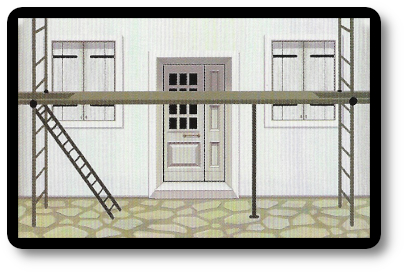
When placing a Floor card, it must be orthogonally placed in a relationship to any previously placed Floor cards. The House Area may never have any more than five houses in total. Scaffold cards can be moved and removed as many times as the player likes, but if they are removed with Floor cards below or above it, it must be replaced with a Floor card.
And if any of the rules above sound like “oh, jeepers, I better not break them”, you are correct. The above rules of Floor card placement are referred to in the instructions as the “Golden Rules”. There are, however, breakable rules.
Each player was provided four Regulatory Bonus tokens when the game was set up. These can be “cashed in” to break the above rules, but players can only do so four times per game. In addition, it costs the player three Coins to break the rules. If the player wants to break these rules, they must spend Coin and Regulatory Bonus tokens. If they cannot they must adhere to the following rules:
- All three Floor cards in a column found in the player’s House Area must be the same color
- Adjacent houses in the player’s House Area may never be the same color
Step Three: Visit from Characters
If the player completes a building (that is, all three cards are in a column, creating a three-storied building), a character will now walk by and have a visit. For each building completed on the players turn, they must draw one Character card and place it underneath a completed building. The Character cards score points at the end of the game, with the number of points scored is equal to what the card states at the end of the game.
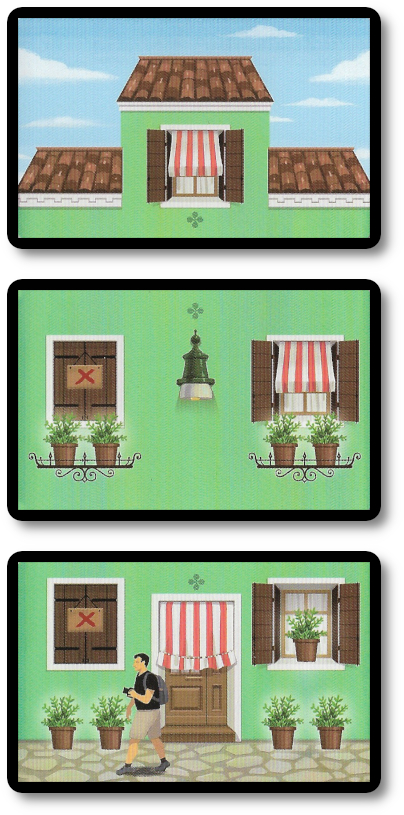
This column can now be scored
There are two types of visitors. These are Tourists and Inhabitants. Players are limited to being visited by each Inhabitant once per game (i.e. you cannot have the “Mayor” Character card in the player’s tableau more than once), but a player can be visited by Tourists multiple times. The easiest way to know the difference between an Inhabitant and a Visitor is the picture on the Character card. Inhabitants go by their role in town (Mayo, Policeman, Santa,, etc.), while Visitors go by their gender (Woman, Man, Girl, and Boy).
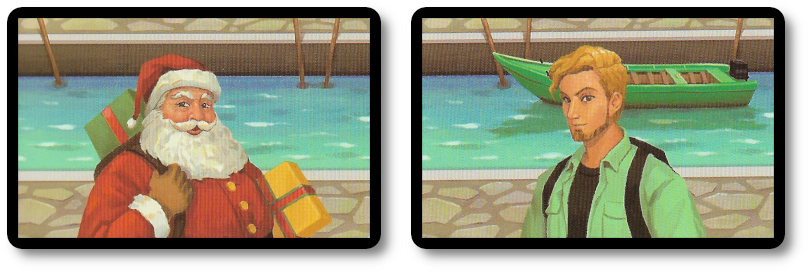
Note that a house is not complete if one of its three cards is a scaffold!
Step Three: Know Your Limits
The player’s turn is now over. They must now discard down to the maximum number of cards and coins.
- Maximum of three Floor cards in hand (return extras to the bottom of the deck of the player’s choice)
- Maximum of six Coins (return extras to the Bank)
This completes the players’ turn. The next player now goes using the steps above.
End of the Round and Preparing for the Next
After each player has taken their turn, the round is over and a new round begins, but only if none of the players have completed five buildings. If one or more players have, the game ends. If not, the Starting Player token is passed and the Floor Supply is refilled.
Ending Your Visit
The game ends if any player has completed five buildings with five Character cards by the end of the round. Players now score. Points are scored by characters, shops, and regulatory bonuses. However, players lose points if they are found to be the player with the most closed windows. Burano is a place that welcomes all, and closed windows sends a negative message. The scoring card reference aids are handy here, as is the score pad. When all the points are calculated, the player with the highest score wins the game. Ties are broken using the Coins, with victory going to the player who has the most.
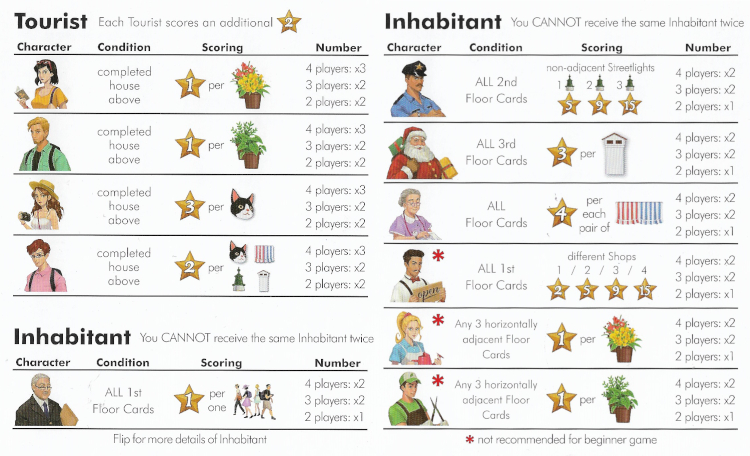
Game Variants
Walking in Burano can be played with only two players or solo if no other players are around. Both game variants have a similar game set up, but the gameplay is slightly different. The game ends when five buildings are completed or there are no more Character cards.
To learn more about Walking in Burano, visit the game’s web page.
Final Word
 The Child Geeks jumped right in and had a good time. The card drafting and building of the houses were found to be intuitive and entertaining in equal portions. According to one Child Geek, “I like how you can build your homes and the colors are pretty. I especially like that you can have Santa visit you!” Another Child Geek said, “It is easy to build a house, but if you want to win, you need to make sure you build your homes in a way that makes people want to see them. That’s where the big points are.” This Child Geek is right on. What you build is nice, but who visits them is what scores you points. Speaking of which, all the Child Geeks voted and approved of this little gem, giving it full points for fun.
The Child Geeks jumped right in and had a good time. The card drafting and building of the houses were found to be intuitive and entertaining in equal portions. According to one Child Geek, “I like how you can build your homes and the colors are pretty. I especially like that you can have Santa visit you!” Another Child Geek said, “It is easy to build a house, but if you want to win, you need to make sure you build your homes in a way that makes people want to see them. That’s where the big points are.” This Child Geek is right on. What you build is nice, but who visits them is what scores you points. Speaking of which, all the Child Geeks voted and approved of this little gem, giving it full points for fun.
 The Parent Geeks were also impressed with the game. According to one Parent Geek, “I’ve been to Burano and it is truly a magical and beautiful place. This game brought back a lot of happy memories and was fun to play. Double win for me.” Another Parent Geek said, a simple game to explain, a fun game to play, and a hard game to win. I enjoyed it a great deal and plan on getting myself a copy at Gen Con!” The Parent Geeks were particularly impressed by the game’s depth of play that seemed to only get more and more interesting as the game progressed. That is to say, the Parent Geeks all saw that the game itself start out very easy to grasp and to manage. As you progress, the player has to make harder and harder decisions. This gradual but predictable learning curve drew them in and kept them playing. The end result is a full endorsement from the Parent Geeks.
The Parent Geeks were also impressed with the game. According to one Parent Geek, “I’ve been to Burano and it is truly a magical and beautiful place. This game brought back a lot of happy memories and was fun to play. Double win for me.” Another Parent Geek said, a simple game to explain, a fun game to play, and a hard game to win. I enjoyed it a great deal and plan on getting myself a copy at Gen Con!” The Parent Geeks were particularly impressed by the game’s depth of play that seemed to only get more and more interesting as the game progressed. That is to say, the Parent Geeks all saw that the game itself start out very easy to grasp and to manage. As you progress, the player has to make harder and harder decisions. This gradual but predictable learning curve drew them in and kept them playing. The end result is a full endorsement from the Parent Geeks.
 The Gamer Geeks recognized this drafting and set collecting card game for what it was: a smart and casual game. According to one Gamer Geek, “I always enjoy games like this. The rules are simple, but not the gameplay. The multiple different levels of scoring make each turn important and you can build out your strategy as you progress, but are still free to change it without ever putting yourself in jeopardy of getting behind.” Another Gamer Geek said, “I find the game to be simple, but I enjoyed it. I’d play it again.” All the Gamer Geeks agreed that they enjoyed it and that the game needed more cards. I do know there is an expansion either in the works or due to be released, so that was good news for them.
The Gamer Geeks recognized this drafting and set collecting card game for what it was: a smart and casual game. According to one Gamer Geek, “I always enjoy games like this. The rules are simple, but not the gameplay. The multiple different levels of scoring make each turn important and you can build out your strategy as you progress, but are still free to change it without ever putting yourself in jeopardy of getting behind.” Another Gamer Geek said, “I find the game to be simple, but I enjoyed it. I’d play it again.” All the Gamer Geeks agreed that they enjoyed it and that the game needed more cards. I do know there is an expansion either in the works or due to be released, so that was good news for them.
 Walking in Burano proves again that you don’t need a big boxed game for big fun at the gaming table. This small game kept everyone we played with engaged and happy, from the first card drawn to the last point scored. Part of this comes from the gameplay, wherein players get to build their little houses. There is a real sense of accomplishment when you see your colored homes being construction and finally draw in tourists and locals alike to gawk. The feeling from all our groups was one of accomplishment, if not flat-out pride in their work. Which is funny when you, again, consider how small this game is.
Walking in Burano proves again that you don’t need a big boxed game for big fun at the gaming table. This small game kept everyone we played with engaged and happy, from the first card drawn to the last point scored. Part of this comes from the gameplay, wherein players get to build their little houses. There is a real sense of accomplishment when you see your colored homes being construction and finally draw in tourists and locals alike to gawk. The feeling from all our groups was one of accomplishment, if not flat-out pride in their work. Which is funny when you, again, consider how small this game is.
I feel compelled to state that I have no idea why Santa is a character in the game. It might as just as well be any other character, but for some reason, the publishers went with Old Saint Nicolas. Which is, admittedly, peculiar. The current theory is that Santa is the Character card because the player gets points if their five buildings all have roofs. As in roofs for Santa to visit. Maybe. If you have ideas, please share them in the comments below. It’s a puzzle.
This is a fun little game, perfect for casual players and for more hardcore players who want to game but might not have the time or energy. It keeps you on your toes, plays fast, and invites you to think both in the long and short-term. Building a complete tableau is not just enough. You have to build for a reason and gather your points accordingly. Or don’t. This is a game that wants you to have fun, even if you are not particularly aggressive or competitive in your gameplay. Perfect for a game with the family, with your casual gaming friends, or when you have some time to kill with your gaming elitist pals.
This game was given to Father Geek as a review copy. Father Geek was not paid, bribed, wined, dined, or threatened in vain hopes of influencing this review. Such is the statuesque and legendary integrity of Father Geek.



